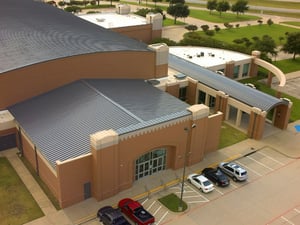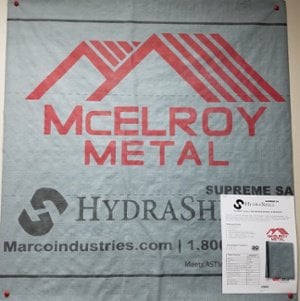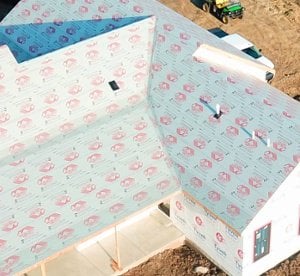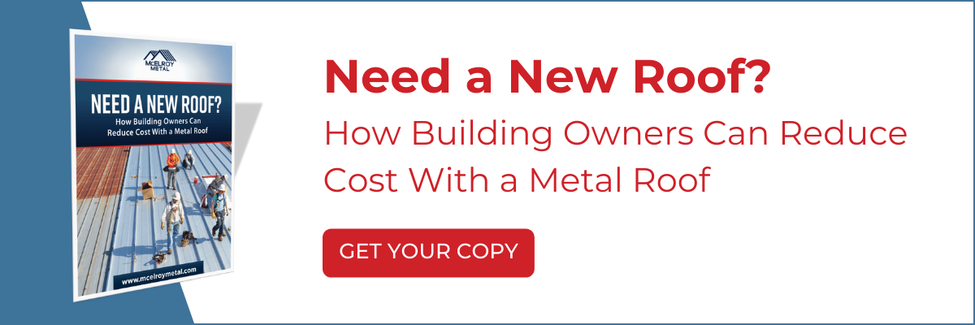Standing Seam Metal Roof Underlayment
Whether you are a contractor or a building owner, standing seam metal roofs are an excellent option for an attractive, durable roof.
What Are Standing Seam Systems?

Is a standing seam system the right choice for your project?
Our eBook, "Need a New Roof? How Building Owners Reduce Cost with a Metal Roof", helps building owners understand their reroofing options and present the features and benefits of Metal-Over-Metal Recover Systems.
While choosing the right standing seam panel is the most visible part of your new roof, choosing the best underlayment is equally important.
What is an Underlayment?
Roofing underlayment is a protective barrier between the roof deck and the exterior panel.

So why are underlayments important? Their necessity is two-fold. Not only do they allow the structure to be dried in during the construction phase, they ultimately provide a secondary barrier of weather protection to the structure. If by chance water were to penetrate the top layer in any way (i.e., improper installation, blow-offs due to storm damage, etc.), underlayments provide a protective layer that will shed water away instead of letting it come into the building.
There are many different types of underlayment materials, and like many other products, the options have evolved and significantly improved over time. Asphalt-saturated felt was the typical underlayment material in the past, but this product had some flaws. Asphalt-saturated felt required multiple rolls to be used, buckled and wrinkled as it was rolled out, and degraded faster than building owners would have liked.
Standing Seam Metal Roof Underlayment

As mentioned earlier, an underlayment provides an additional layer of protection, helping to prevent mold and other damage over the life of the building. But there's no one-size-fits-all approach to the underlayment. Climate, roof slope, and even the roofing product (metal or shingles, etc.) all contribute to underlayment decisions.
Recently, synthetic underlayments have been preferred because they solve some of the problems associated with asphalt-saturated felt. For instance, fewer rolls are typically needed; they are easier to handle and maneuver, are faster to install, and lay smoother than asphalt-saturated, so there's less telegraphing through the roof. Additionally, synthetic underlayment is safer to walk on during installation and boasts a much longer life expectancy than other underlayment products.
Synthetic underlayments are generally manufactured in two different categories: mechanically fastened and self-adhered, which is often referred to as peel & stick.
Synthetic-Mechanically Fastened Underlayment
Mechanically fastened underlayments are just that…fastened mechanically to the substructure. Various underlayments have differing requirements on how many fasteners to use and which fasteners are appropriate, but all ultimately require some type of fastener to hold them in place.
Synthetic-Self Adhered Underlayment
Self-adhered underlayments are true to their name as well. They are manufactured with an adhesive on the back side that allows them to adhere to the roof deck without having to use a fastener. While these products can be used to cover the entire roof, they are most generally used in the valleys and eaves and around penetrations such as skylights and chimneys. Code requirements vary, but a self-adhered underlayment should typically be used at least 2 feet inside the exterior walls.
Synthetic Underlayment FAQ's
1. What temperature thresholds should I install synthetic underlayment?
Mechanically fastened underlayments generally don't have temperature limitations. However, self-adhered underlayments generally do. Asphalt-backed self-adhered underlayments should be installed between 40°F and 125°F.
2. How long can synthetic underlayments be exposed before putting on the final roof?
This will vary based on the underlayment, but generally, synthetic underlayments have UV inhibitors added to the polymers, allowing them to be exposed between 90 and 180 days. However, there are exceptions on both ends of the spectrum.
3. What is the warranty on synthetic underlayments?
Again, this will vary depending on the underlayment. Warranties vary from zero to lifetime. The buyer should pay particular attention to the warranty they get when purchasing any product.
4. Are there any special considerations for peel-and-stick underlayments for metal roofs?
Peel and Stick Underlayments have temperature ratings. When installed with metal roofing, use underlayments designed for metal roofing with a temperature rating of at least 240 degrees.
5. How do I install synthetic underlayments?
Most synthetic underlayments provide written installations through the distributor or the packaging itself. However, you always start at the low point of the roof and run the product horizontally, overlapping each row in a shingling fashion. When purchasing and installing a self-adhered underlayment, some products offer a split back release liner, which allows the film to come off in two pieces instead of one. A split back release liner helps with the installation of a self-adhered underlayment, as it is easier to handle.
Team Up With A Pro!
The best way to ensure that your roofing system and underlayment are working together to maximize the lifespan of your roof is to work closely with a contractor who has experience installing standing seam systems in your climate. If you'd like to find a contractor or distributor in your area, use our database to find a trusted professional!
Standing seam roofs offer all the practical advantages of McElroy Metal products and a wide range of design options to enhance your project. Get the most out of this smart investment by pairing it with the right underlayment to ensure a weather-tight, durable metal roof.
About McElroy Metal
Since 1963, McElroy Metal has served the construction industry with quality products and excellent customer service. The employee-owned components manufacturer is headquartered in Bossier City, La., and has 14 manufacturing facilities across the United States. Quality, service and performance have been the cornerstone of McElroy Metal’s business philosophy and have contributed to the success of the company through the years. As a preferred service provider, these values will continue to be at the forefront of McElroy Metal’s model along with a strong focus on the customer.



.png?width=767&name=What%20to%20Expect%20When%20You%20Order%20From%20McElroy%20Metal%20(1).png)


.png?width=440&height=293&name=How%20to%20Install%20Metal%20Roofing%20Over%20Existing%20Metal%20Roofs%20(1).png)


Comments on this article:
Scroll down to the bottom to submit a comment and join the conversation. Need help or have a question? Please contact us. Looking for a distributor or contractor? Please click here to get started.